Membrane Transport
Plasma membrane 是每個細胞的外層保護膜,它包含許多元素,如 phospholipids, cholesterol, proteins 和 carbohydrate groups,並且是以 fluid mosaic model 的架構來定義。Diffusion 是指高濃度的分子會不斷的從高濃度的區域移動到低濃度的區域,以達到平衡的狀態,而 Osmosis 則是在不同濃度的兩個區域中間加入一個 semipermeable membrane 的情況下,水分子會由低濃度區域流向高濃度區域,稱為 Tonicity。Membrane transport 是指細胞膜上的載體分子利用能量穿過膜的機制來將物質從一個區域輸送到另一個區域的過程。
The plasma membrane
每個 cell 都是被包覆在 membrane 泡沫當中
- membrane 的質地其實就像沙拉油一樣
- 看起來隨便就可以破掉,但其實非常適合作為 cell 的包裝
- Membrane 的工作有很多
- 包覆 cell
- 與外部環境互動
- 輸入輸出一些物質
- 認知其他 cells,並跟其溝通
為了能處理這些工作,membrane 必須包含 lipids (semi-permeable barrier), proteins (transport, communication), carbohydrates (decorate lipids and proteins, recognition)
Fluid mosaic model
現今最正確稱呼 membrane 架構的說法為 fluid mosaic model
- fluid mosaic model (1972) 用來定義各種 cells 的 membrane 架構
- 元件 (phospholipids, cholesterol, proteins 等) 自由浮動在 membrane 的平面上
- 像 mosaic 一樣的鑲嵌畫板
- 例如下圖只是 membrane 在 dynamic process 中的任一 snapshot 而已
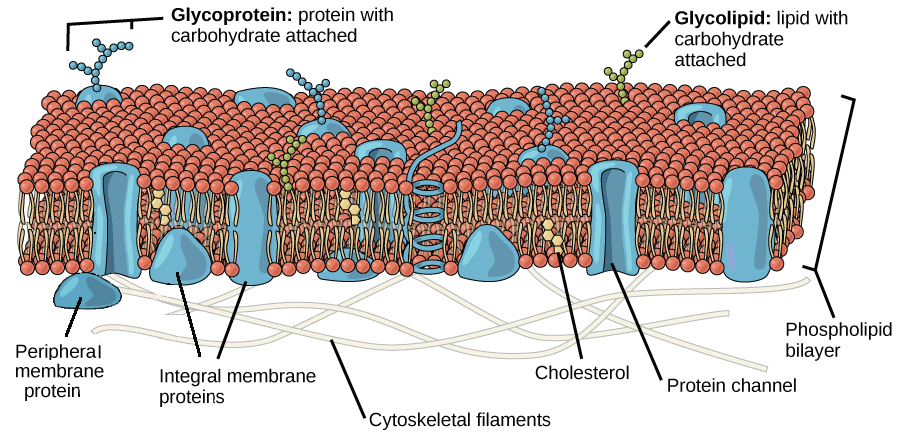
Membrane 主要元素有 lipids (phospholipids, cholesterol), protein, carbohydrate groups 附在一些 lipids 和 proteins 上面
- Phospholipid 由 1 個 glycerol 和 2 個 fatty acid tails 還有 1 個 phosphate group 的頭組成
- 生物細胞的 membranes 主要會有兩層 phospholipids 形成 phospholipid bilayer
- Cholesterol 主要由 4 個 fused carbon rings 組成
- 主要影響 fluidity
- Proteins 有的作為橫跨整個 membrane 作為通道,有的只出現在內外表面
- 又可以分成 integral membrane protein 和 peripheral membrane protein
- Integral membrane protein 能夠穿過整個 membrane 的又叫 transmembrane proteins
- Carbohydrate groups 只出現在外部,作為 ID markers 讓 cell 互相辨識
- 和 proteins 形成 glycoproteins
- 和 lipids 形成 glycolipids
在人類細胞的 membranes 中,proteins 佔了約 50%,lipids 40%,carbohydrates 10%
Diffusion and osmosis
植物沒有澆水就會萎縮,這是因為水分子都從細胞跑出來了,但為什麼 ?
- 這是因為 osmosis 作用發生
- 隨著外部 solute concentration 的增加
- 它們能夠將水分子從 cell 中拉出來
正式來說,osmosis 指的是水從 lower solute concentration 區域通過 semipermeable membrane 到 higher solute concentration 區域所產生的 net movement
- semipermeable 代表只有水分子可以穿過但一些 molecule 無法穿過的意思
- osmosis 對於生物的一些作用十分重要,特別是跟 solute diffusion, transportion 有關的
Diffusion
要了解 osmosis 之前,先來了解基本的 diffusion 作用
- 通常 higher concentration 的 molecules 最終會和 lower concentration 形成平衡
- 也就是高濃度區域的 molecules 會移動到低濃度的區域
- 這不是什麼定理,只是單純的機率問題
- 因為 molecules 只是隨機跳動,高濃度的區域一定更高機率移動到低濃度區域
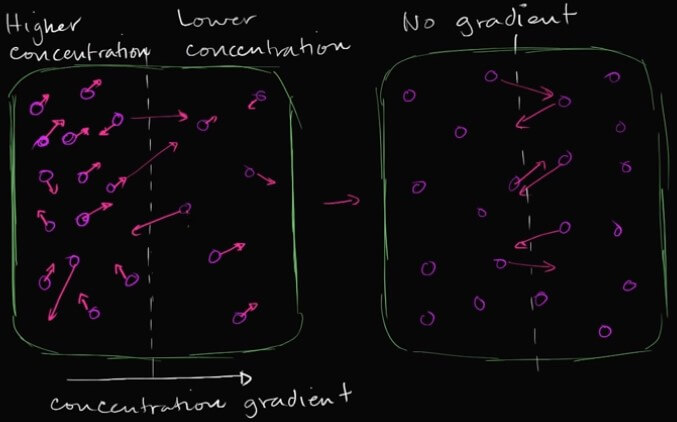
Osmosis
基於一般 diffusion 的現象,我們在 higher 和 lower concetration 中間加入一個 semipermeable membrane,並且加入一個 solute 到其中一邊,他將影響整個機率問題 !
- 有很多的理論提出不同的原因
- 主要就是新加入的 solute molecules 也在跳動,但無法通過 membrane
- 不斷反彈,影響水分子移動到對面
- 不管理論如何,我們知道某一邊 solute 加入越多,該邊的水就越難流到對面
- 造成低濃度 solute 的水流到高濃度 solute 的區域

Tonicity
細胞外部 solution 讓細胞水分因為 osmosis 作用移動的現象稱為 tonicity
- 一個 solution 的 tonicity 跟他的 osmolarity 有關
- Osmolarity 代表該 solution 中的 solutes 濃度
- 所以當一邊為 low osmolarity 一邊為 high osmolarity
- 水分子就會從 low 移動到 high
- Osmolarity 代表該 solution 中的 solutes 濃度
有三個詞彙可以用來比較細胞內部和外部的 osmolarity,並且通常代表 solute 是無法通過 membrane 的 !
- Hypotonic 代表 osmolarity A < B
- hypo-: less than
- 所以水會往 B 流
- Isotonic 代表 osmolarity A = B
- iso-: the same
- 水很平衡
- Hypertonic 代表 osmolarity A > B
- hyper-: greater than
- 所以水會往 A 流
舉個例子,細胞內部是跟外部的 solute 濃度比起來是 hypertonic,代表外部的濃度跟內部比起來是 hypotonic !
Tonicity in living systems
現在從動物細胞角度來看 tonicity,也就是當細胞置入三種不同的 solution 時
- Place in hypertonic solution
- 水會離開細胞,細胞萎縮
- 紅血球可能會死亡
- Place in isotonic solution
- 不會有水移動
- 紅血球最適合的環境
- Place in hypotonic solution
- 水會進入細胞,細胞膨脹
- 紅血球可能會爆炸
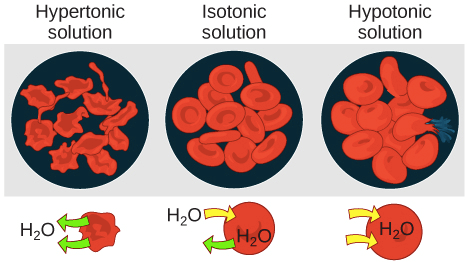
紅血球在 isotonic 環境是最好,但植物則需要 hypotonic 環境才是最好 !
- 因為植物細胞絕對不會被撐破 (cell wall)
- 所以通常植物細胞的 cytoplasm 會比外界還要 hypertonic (讓水流進來)
- 直到達到內部壓力 (turgor pressure) 防止過多水進入
維持 tonicity 關係到植物的死活
- 如果沒澆水,外部可能會變成 isotonic 或是 hypertonic
- 造成水流失,降低 turgor pressure,最終枯萎
- 最終達到 plasmolysis 的狀況 (下圖最左)
- Plasmolysis: membrane detach from wall and constrict the cytoplasm
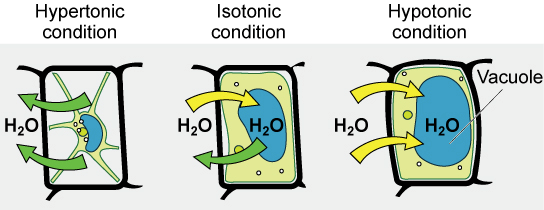
Passive Transport
Plasma membrane 就像機場安檢一樣,控制不同身份的 molecules 通過
- Selectively permeable 管理物質能否進出 cells,以及需要多久時間進出
- 是 cell 保持 homeostasis 的能力
- 幫助 cell 獲得養分、淘汰廢物
Passive transport 是細胞讓物質被動的進出 membrane 方式
- Passive transport 讓 cell 不需花費任何 energy 就能讓物質進出 membrane
- 物質會靠著 concentration gradient 的特性移動
- 就是從高濃度地區移動到低濃度地區
- 物質會靠著 concentration gradient 的特性移動
另外,有的物質能直接從 membrane lipids 穿過,有的則需要從 membrane proteins 穿過 (facilitated diffusion)
Selective permeability
還記得 membrane 上的 phospholipids 是 amphipathic 的嗎 (hydrophilic head + hydrophobic tails)

- 因為 hydrophilic head 上面的 phosphate group 帶有負電
- Polar 或 charged molecules 會較難或無法通過
- 例如水分子在通過 membrane lipids 時,相較於 oxygen 就會來的慢很多
- sodium, potassium, calcium, chloride 則是無法通過 membrane lipids
- 需要透過一些特別的 protein 通道
- sugar, amono acids 也是無法直接通過,需要 protein 幫助
- Polar 或 charged molecules 會較難或無法通過
Passive transport
我們已經知道 diffusion 的原理,而 molecules 為了在內外取得平衡,所以就會透過 diffusion 來移動
- 下圖是隨著時間的增加, diffusion 造成的結果
- 高濃度的地區 molecules 移動到低濃度的地區
- 其實這個 concentration gradient 就是一種 stored (potential) energy

- 每個物質都有自己的 concentration gradient
- 例如外部的 oxygen 濃度較低,而 carbon dioxide 濃度較高
- Oxygen 就會往外移動,而 carbon dioxide 會往內移動 (passively)
Facilitated diffusion
除了一些如 oxygen, carbon dioxide 可以直接通過 membrane lipids 外,其他 molecules 必須要有別人幫助
- Facilitated diffusion 指的就是透過 proteins 幫助通過 membrane
- 因為 molecules 帶有電或 polar,所以會被吸引
- Facilitated transport proteins 提供 shield 讓 molecules 可以順利通過
- 主要的 facilitated transport proteins 有兩種
- channels 和 carrier proteins
- 主要的 facilitated transport proteins 有兩種
Channels
- Channel protein 在 membrane 開出一條 hydrophilic tunnel
- 讓帶有 polar, charged 的 molecules 能透過 diffusion 通過
- 免於接觸 membrane 的 hydrophobic core
- 通常 channel 只給一種類型的 molecules 通過 (或只給一些具有相同特質的)
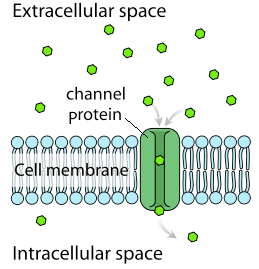
- Aquaporins 是一個很重要的 channel protein
- 控制水分子快速進出 membrane
- 在 plant cells, red blood cells, kidney (部分細胞控制水量流失) 皆扮演重要角色
Channel protein 還有分永遠開啟和可以開關的類別
- 有的 channel 永遠開啟,有的則是有 gated 的架構
- 透過特定 signal 控制開關
- 例如 nerve, muscle cells 都有 ion channels (給 sodium, potassium, calcium ions 通過)
- 幫助 nerve cells 進行 electrical transmission
- 幫助 muscle cells 進行 muscle contraction
Carrier proteins
- Carrier protein 改變形狀讓 molecules 從一邊轉移到另一邊
- 一個 carrier proteins 一樣只給特定類型的 molecules 通過

- Channel 比 carrier 運送的速率還要快很多
- 因為 channel 不需像 carrier 改變形狀,進行 "reset"
- 通常 channel 每秒可運送千萬個 molecules
- 而 carrier 每秒只能運送千個 molecules
Active Transport
假設細胞外的 sugar 比內部多,但又需要更多的 sugar 來進行 metabolic process
- 無法利用 passive transport 來傳送,這時就要利用 active transport
- Active transport 需要細胞消耗 energy (e.g., form of ATP)
- 來對抗 concentration gradient 甚至是 electrochemical gradients
Electrochemical gradients
Concentration gradient 指的是粒子經由濃度的梯度進行移動,Electrochemical gradients 則是粒子另一種移動模式
- 粒子除了濃度外,還能經由"帶電梯度"來移動
- 因為 atom, molecules 都能有 ions 帶正或負電
- 因此在 membrane 的內外形成 electrical gradient (difference in charge)
- 這個梯度一樣形成一股能量 (membrane potential)
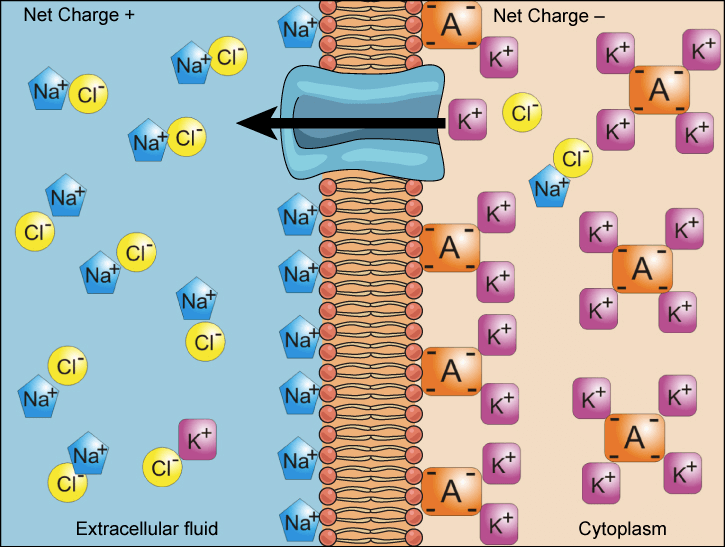
- 通常內部帶有負電,外部帶有正電
- 且內部的負電比外部的正電還要更多
- 一般細胞的 membrane potential 約為 -40 至 -80 millivolts
- 細胞會透過 sodium-potassium pump 來維持 membrane potential
通常來說細胞內跟外界比起來,會有較高濃度的 potassium ,和較低濃度的 sodium
- 根據 concentration gradient
- Sodium 應該會透過 passive transport 由外往內移動
- Potassium 則不會透過 passive transport 由外往內移動
- 相反的, potassium 還會從內往外移動
- 根據 membrane potential
- Sodium 依然由外往內移動
- Potassium 則變為想要由外 (正電) 往內 (負電) 來移動
- 將兩種梯度考慮,造成 ion 移動的影響稱為 electrochemical gradient !
- electro = membrane potential
- chemical = concentration gradient
兩種梯度相撞的 electrochemical gradient,使得 potassium 維持在一個平衡的狀況 !
Moving against a gradient
為了對抗 electrochemical gradient,細胞必須使用 energy
- Active transport 使用 ATP 得到 energy 產生推進的力量
- 事實上細胞會保留 metabolism 產生的 energy 作為 active transport 的燃料
- 例如 red blood cell 會保留 energy 用來維持內外 sodium, potassium level
事實上 active transport 的形式分為兩大類
- Primary active transport
- 直接使用 chemical energy (e.g., ATP) 對抗 gradient 移動粒子
- Secondary active transport
- 利用 active transport 產生的 electrochemical gradient 來移動粒子
- 不會直接使用 ATP 這類 chemical energy
Primary active transport
Primary active transport 最著名的例子就是 sodium-potassium pump
- Sodium-potassium pump 需要使用到 ATP 作為能量來源
- sodium () 被排出細胞
- potassium () 被吸入細胞
Pump 不只維護 sodium 和 potassium 的 concentration 平衡,更扮演控制細胞 voltage 的角色
- 這類能建立又能維護 membrane voltages 的 pump 稱為 electrogenic pumps
- 例如植物中也有 electrogenic pump
- 他使用 hydrogen ions () 來取代 sodium 和 potassium
- 例如植物中也有 electrogenic pump
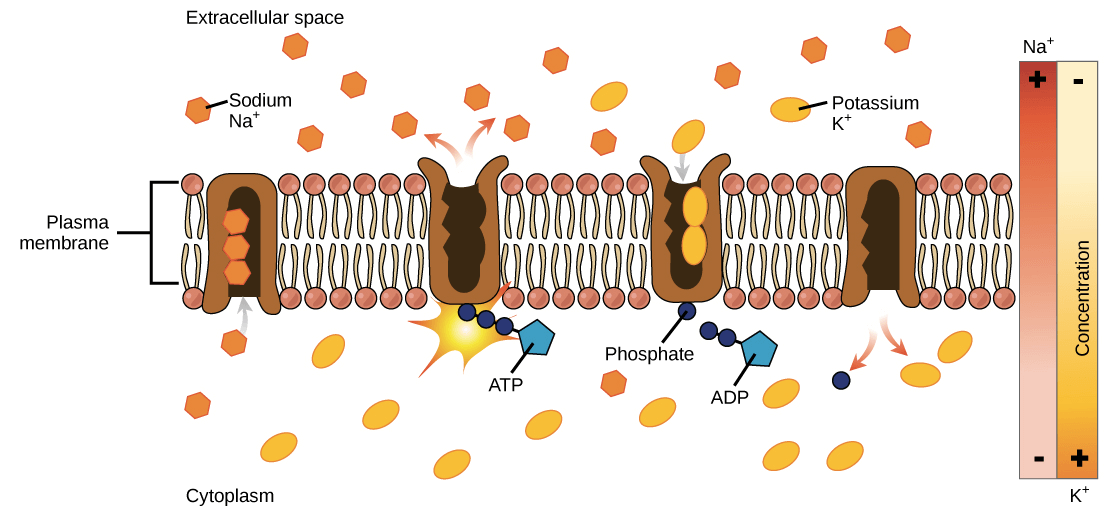
- Sodium-potassium pump 會持續改變形狀來 transport sodium 和 potassium
- 每個 cycle 會吐出 3 個 sodium 和得到 2 個 potassium
- 主要可以分為 6 個步驟
- pump 一開始向細胞內部打開,吸引 sodium ions 來結合 (3 個)
- 結合完畢, pump 會 hydrolyze (break down) ATP
- ATP 的 phosphate group 會和 pump 結合 (pump 被 phosphorylated)
- ADP 會被釋放掉
- Phosphorylation 讓 pump 改變形狀,變成開口朝外
- Pump 不再喜歡 sodium ions,所以將他們都釋放出去
- Pump 變成喜歡和 potassium ions 結合 (2 個)
- 結合後,將 phosphate group 移除掉
- 失去 phosphate 的 pump 又變回原本的形狀,開口朝內
- Pump 不再喜歡 potassium,將 2 個 potassium 釋放到細胞中
- 變回步驟一的模樣,完成一個 cycle
看起來複雜,其實只是 protein 靠著 ATP 的 phosphate group 變換兩種形狀而已
- 朝內的形狀對 sodium 有 high affinity
- 朝外的形狀對 potassium 有 high affinity
Sodium-potassium pump 如何產生 membrane potential,以下是根據 stoichiometry 的簡單計算
- 3 個 sodium ions 離開,和 2 個 potassium ions 進入的確產生些微的負電
- 但只是產生 membrane potential 的非常小的原因
- 主要原因是內部大量濃度的 potassium ions
- 這讓 potassium 的 concentration gradient 非常陡峭
- 陡峭到能夠對抗 voltage (內部負電) 往外流出
- 這個流出現象會持續到 electrochemical gradient 重新平衡為止
至此,只要 potassium 持續在細胞內部佔高濃度,細胞內比外面 charge 就會更加 negative
Secondary active transport
運用上面所講的 electrochemical gradient 所儲存的 energy,來運送物質的就是 secondary active transport
- 例如 sodium-potassium pump 在運送 sodium ions 的時候
- Sodium ions 經由 concentration gradient 移入細胞
- 這時候 glucose 可以和 sodium ions 透過 shared carrier protein (cotransporter) 結合
- Cotransporter 運用 sodium 的 gradient 一起將兩者送入細胞當中
可以從下圖看到,glucose 是逆著自己的 concentration 從外到內移動的 !

另外 cotransporter 又可以分成兩種,像上圖 sodium ions 和 glucose 是朝同方向移動的
- 兩種粒子往同樣方向的稱為 symporter
- 兩種粒子往相反方向的稱為 antiporter
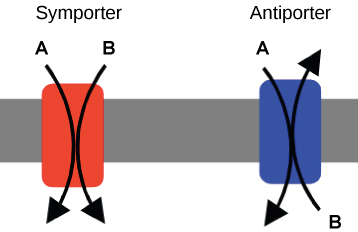
Bulk transport
上面講完 ions, molecules, sugar 等小型物體穿過 membrane 的方法 (channel, transporters),那更大的物體呢 ?
- 細胞需要 bulk transport mechanisms 來讓大型粒子穿過 membrane
- 例如Macrophages 將 membrane 延伸成像"手臂"一樣
- 然後將整個 pathogen 包裝在一個球形 membrane (food vacuole) 吃進細胞當中
Macrophages 是 bulk transport 很好的例子,不過通常細胞不會直接把整個微生物吃掉
- 有的細胞會透過 bulk transport 來獲取養分
- 從外部水分中"抓取"需要的粒子
- 有的細胞釋放 signaling molecules
- 用於和周圍細胞交流
Bulk transport 一樣需要使用到能量 (like active transport),甚至要更多能量 (energy-intensive)
- 以下來了解幾種重要的 bulk transport
- phagocytosis
- pinocytosis
- receptor-mediated endocytosis
- exocytosis
Endocytosis
Endocytosis 泛指用 membrane 將粒子包覆成 vesicle 吸入的 active transport
- Endocytosis
- endo = internal
- cytosis = transport mechanism
- 所有類型的 endocytosis 都擁有相同特性
- membrane 會 invaginates (往內陷) 形成 pocket 圍饒著目標粒子
- 特殊的 proteins 會幫助把粒子包覆成 vesicle (vacuole) 送入細胞
Phagocytosis
Phagocytosis (literally: cell eating) 把粒子直接吃進細胞 (Macrophages 那個例子)
- 當細胞成功吞噬粒子後
- 形成一個 membrane-bound compartment 稱為 food vacuole
- Food vacuole 隨著路線來到了 lysosome (recycling center)
- Lysosome 有 enzymes 能將 vacuole 分解成 basic components (e.g., amino acids, sugars)
- 然後粒子就可以被細胞使用
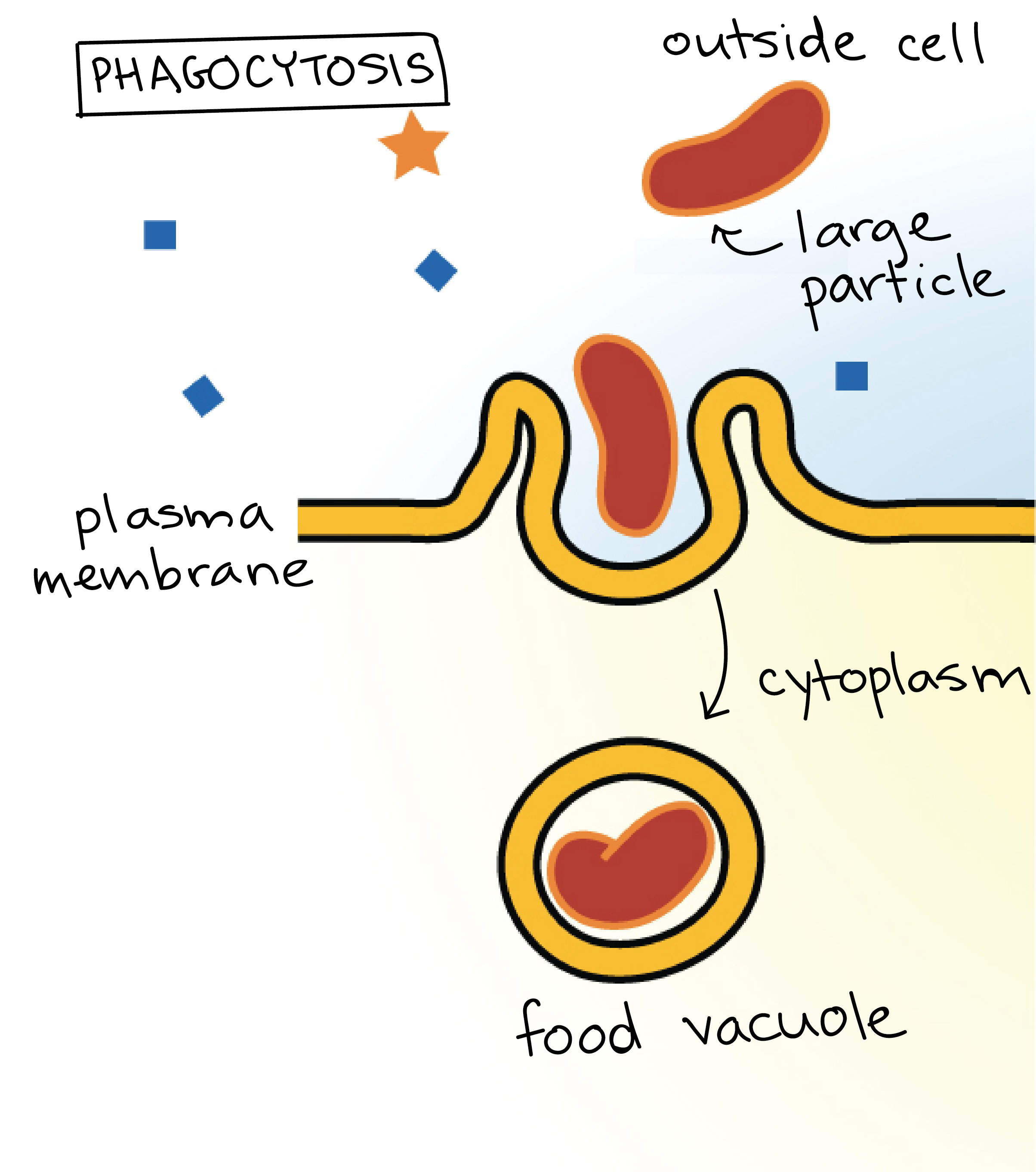
一些 Single-celled eukaryotes (e.g., amoebas) 也是用 phagocytosis 來捕捉獵物
Pinocytosis
Pinocytosis (literally: cell drinking) 則是將水和一些小粒子一起喝進細胞
- Pinocytosis 通常會不斷進行
- 跟著 cell-sampling, re-sampling 從水中獲得養分
- vesicle 會比 phagocytosis 的 food vacuole 還要小很多
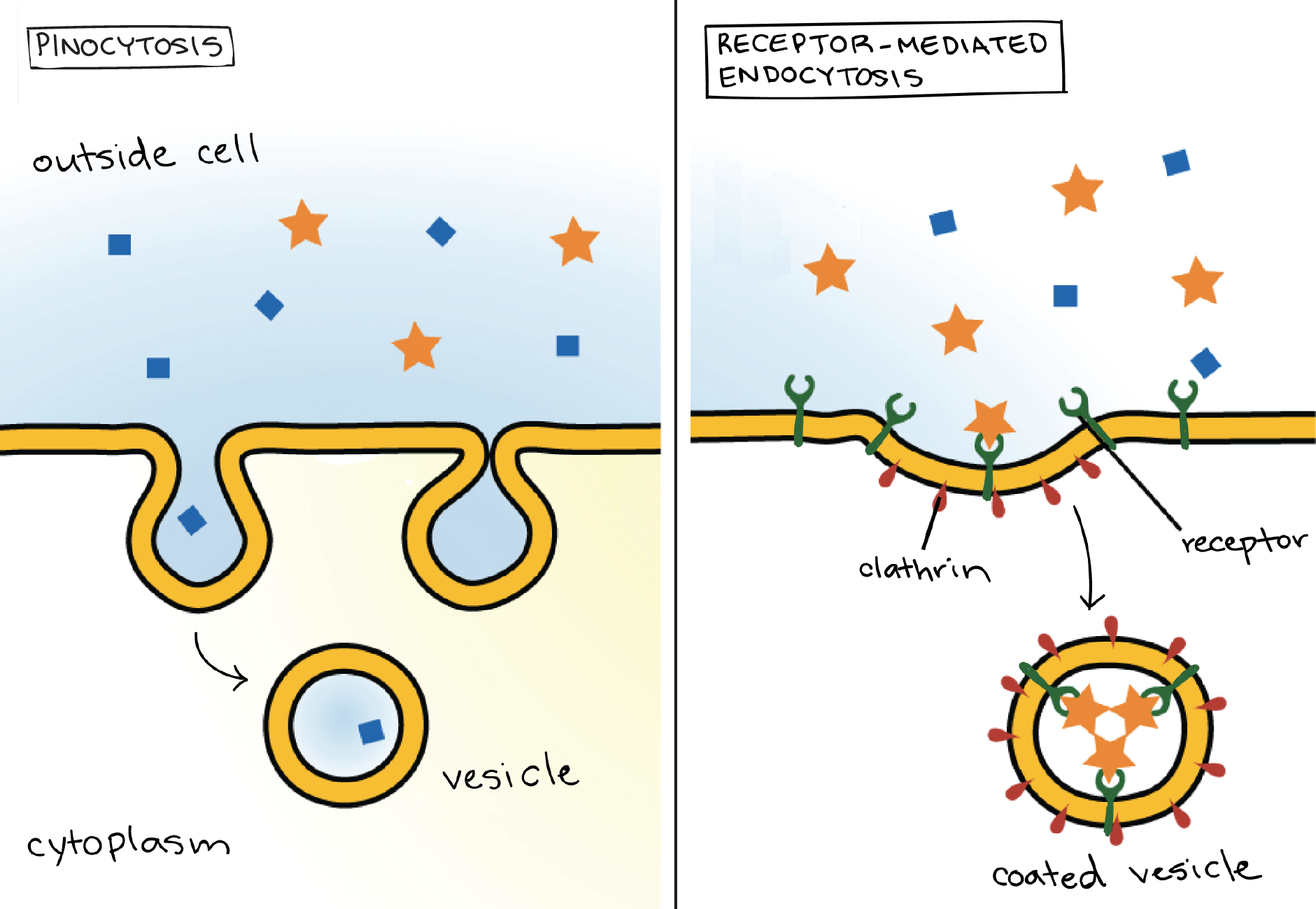
圖左是 pinocytosis,圖右是接下來要講的 receptor-mediated endocytosis
Receptor-mediated endocytosis
Receptor-mediated endocytosis 利用 membrane 表面上的 receptor proteins 作為中介來捕捉粒子
- Receptors (transmembrane proteins)
- 群聚在 membrane 作為 coated pits
- 名字由來為細胞內部的 coat proteins (上圖的 Clathrin)
當 receptors 和目標粒子結合後一樣包覆成 vesicle
- Coat proteins 幫助結合並運送進來
- Receptor-mediated endocytosis 可以運送大量較珍貴的粒子 (low concentration in fluid)
- 但有些不友善粒子也可能隨著 receptor-mediated 的通路進入細胞
- 例如 flu viruses, diphtheria, cholera toxin, ...
Exocytosis
細胞除了要吸收養分,也要排除廢物,傳遞出訊號
- Exocytosis
- exo = external
- cytosis = transport mechanism
- 就是由內到外的 bulk transport
- 常用於釋放 signaling proteins, waste products 到外部
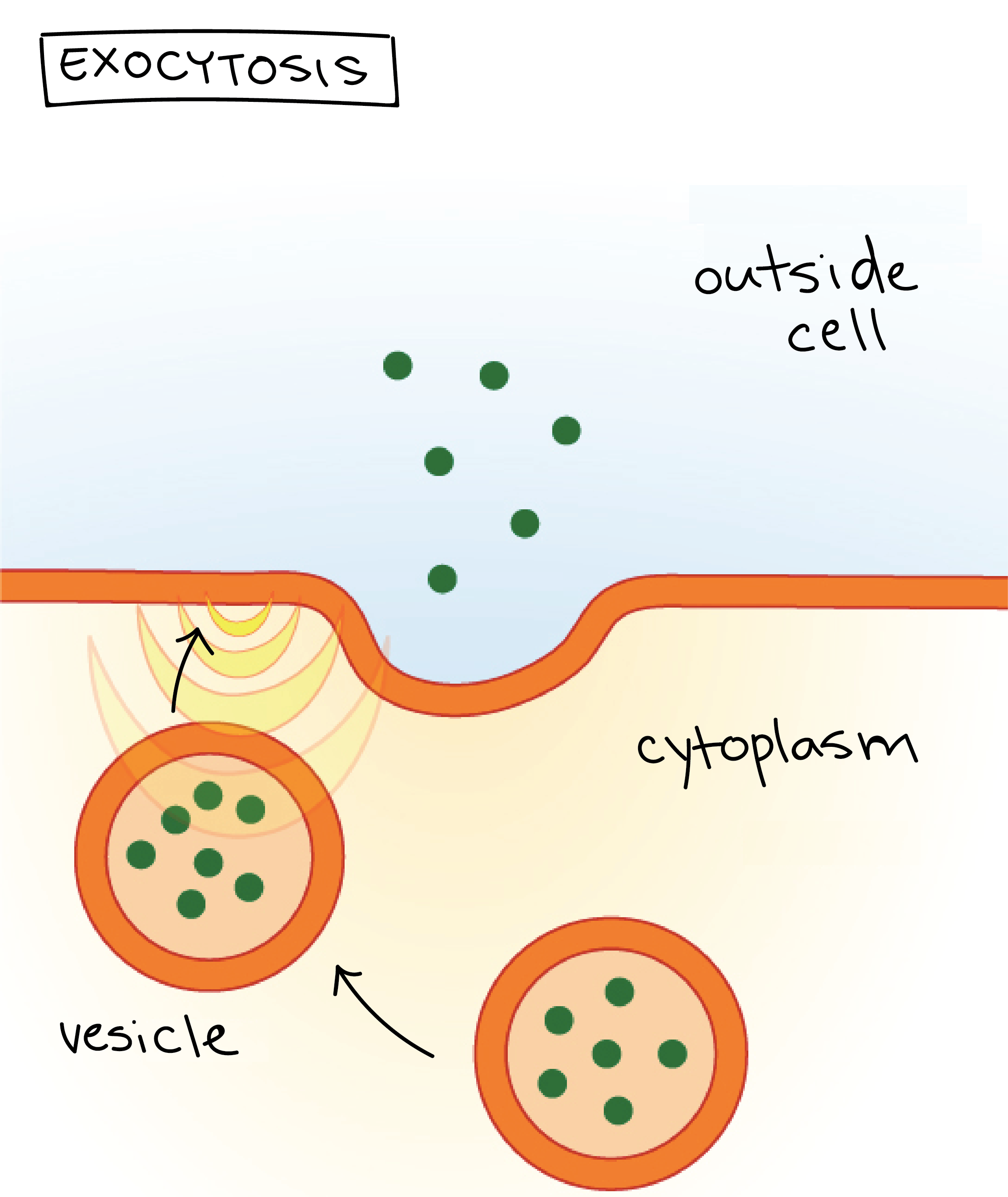
- 要釋放的物質通常以 vesicle 形式從 Golgi apparatus 而來
- 這些 vesicles 會以兩種方法來釋放物質
- 一種是 vesicle 完全跟 membrane 融合在一起,成為 membrane 新的一部分
- 一種採取 "kiss-and-run" model
- 只融合一部分 (kissing the membrane),足夠排出物質就回到細胞內